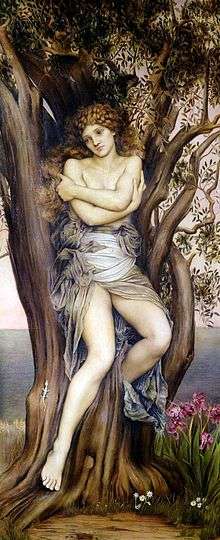Dryad
 The Dryad by Evelyn De Morgan. | |
| Grouping | Legendary creature |
|---|---|
| Similar creatures | Nymph, elf |
| Country | Greece |
A dryad (/ˈdraɪ.æd/; Greek: Δρυάδες, sing.: Δρυάς) is a tree nymph or tree spirit in Greek mythology. Drys signifies "oak" in Greek, and dryads are specifically the nymphs of oak trees, but the term has come to be used for all tree nymphs in general.[1] They were normally considered to be very shy creatures except around the goddess Artemis, who was known to be a friend to most nymphs.
Types
| Greek deities series |
|---|
| Nymphs |
Daphnaie
These were nymphs of the laurel trees.
Epimelides
The Maliades, Meliades or Epimelides were nymphs of apple and other fruit trees and the protectors of sheep. The Greek word melas--from which their name derives--means both apple and sheep. Hesperides, the guardians of the golden apples were regarded as these type of dryad.
Hamadryad
Dryads, like all nymphs, were supernaturally long-lived and tied to their homes, but some were a step beyond most nymphs. These were the hamadryads who were an integral part of their trees, such that if the tree died, the hamadryad associated with it died as well. For these reasons, dryads and the Greek gods punished any mortals who harmed trees without first propitiating the tree-nymphs. (associated with Oak trees)
Meliai
The dryads of ash trees were called the Meliae.[1] The ash-tree sisters tended the infant Zeus in Rhea's Cretan cave. Gaea gave birth to the Meliae after being made fertile by the blood of castrated Uranus. The Epimeliad were nymphs associated with apple trees, and the Caryatids were associated with walnut trees.[1]
Names
Some of the individual dryads or hamadryads are:
In popular culture

- Dryads are mentioned in Milton's Paradise Lost, in the works of Coleridge, and in Thackeray's novel The Virginians.[10] Keats addresses the nightingale as "light-winged Dryad of the trees", in his "Ode to a Nightingale". In the poetry of Donald Davidson they illustrate the themes of tradition and the importance of the past to the present.[11] The poet Sylvia Plath uses them to symbolize nature in her poetry in "On the Difficulty of Conjuring up a Dryad", and "On the Plethora of Dryads".[12]
- The story "Dear Dryad" (1924) by Oliver Onions features a dryad influencing several romantic couples through history.[13]
See also
- Ghillie Dhu, a similar Scottish spirit
- Kodama, a similar Japanese spirit
- Green spirit
- Elf
- Querquetulanae, Roman nymphs of the oak
- Salabhanjika, a similar Indian spirit
References
Citations
- 1 2 3 Graves, ch. 86.2; p. 289
- ↑ Bibliotheca 2. 1. 5
- ↑ Tzetzes on Lycophron, 480
- ↑ Ovid, Metamorphoses 9.330 ff
- ↑ Antoninus Liberalis, Metamorphoses 32
- ↑ Pausanias, Description of Greece, 8. 4. 2
- ↑ Propertius, Elegies 1. 18
- ↑ Nonnus, Dionysiaca 2. 92 ff :
- ↑ Pausanias, Description of Greece 10. 32. 9
- ↑ J. Simpson, E. Weiner (eds), ed. (1989). "Dryad". Oxford English Dictionary (2nd ed.). Oxford: Clarendon Press. ISBN 0-19-861186-2.
- ↑ Martha E. Cook (1979). "Dryads and Flappers". The Southern Literary Journal. University of North Carolina Press. 12 (1): 18–26. JSTOR 20077624.
- ↑ Britzolakis, Christina (2000). Sylvia Plath and the theatre of mourning. Oxford English Monographs. Oxford University Press. pp. 85–86. ISBN 0-19-818373-9.
- ↑ Norman Donaldson, "Oliver Onions", in E.F. Bleiler, ed. Supernatural Fiction Writers. New York: Scribner's, 1985. pp.505-512. ISBN 0684178087
Bibliography
- Graves, Robert (1955). Greek Myths. London: Penguin. ISBN 0-14-001026-2.
- Burkert, Walter, 1985. Greek Religion (Cambridge: Harvard University Press).
External links
| Wikimedia Commons has media related to Dryads. |
- Greek Mythology Link: Nymphs.
- Hans Christian Andersen, "The Dryad", 1868 (e-text)
- Andersen, H. C.; Craigie (transl.) "The Dryad" Fairy tales and other stories London; Toronto: Oxford University Press. 1914
- Tim Hoke, "The Dryad", 2002 (e-text; strong language)